原文地址:Let’s Build A Simple Interpreter. Part 8.
今天我们会讨论 一元操作符, 也就是一元加(+)/减(-)操作符。
今天的很多材料都是基于前一篇文章中的内容,所以如果你需要复习的话,就回到第七部分 再来一遍。记住:重复是学习之母。
闲话说完,以下是今天要做的事:
- 扩展语法使它能处理一元加减操作符
- 增加一个新的
UnaryOpAST 结点类 - 扩展 parser 使它能生成带有
UnaryOp结点的 AST - 扩展 interpreter 并添加一个新的
visit_UnaryOp方法来解释一元操作符
让我们开始,好吗?
到现在为止我们只用到了二元操作符(+,-,*,/),即作用于两个操作数的操作符。
那么什么是一元操作符呢?一元操作符是只作用于一个操作数上的操作符。
下面是一元加减操作符的规则:
- 一元减(-)操作符返回它数值操作数的相反数
- 一元加(+)操作符返回它数值操作数的原数
- 一元操作符的优先级比二元操作符+,-,*,/高
在表达式 “+ - 3” 中第一个 ‘+’ 操作符表示的是一元加操作符,第二个 ‘-’操作符表示了 一元减操作符。表达式 “+ - 3” 等价于 “+ (- (3))” 都等于 -3。你也可以说表达式中的 -3 是一个负整数,但在我们的情况中把它当作一元减操作符,而 3 是它的正整型操作数:
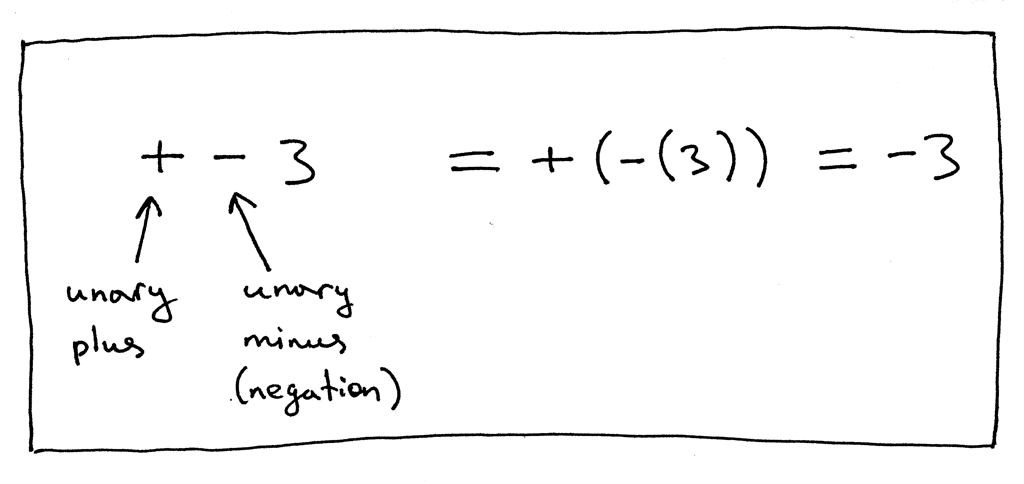
Figure 1: exp1
+ - 3 = + (- (3)) = -3 | \ \ unary minus(negation) unary plus
让我们再看看另一个表达式,“5 - - 2”:
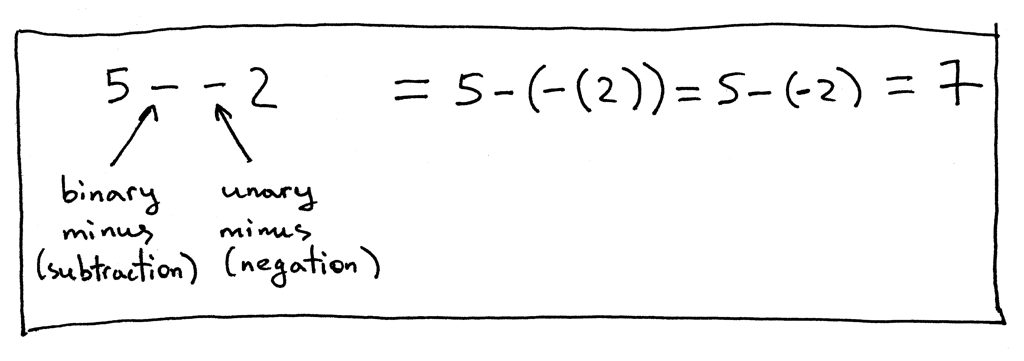
Figure 2: exp2
5 - - 2 = 5 - (- (2)) = 5 - (- 2) = 7
| \
\ unary minus(negation)
binary minus(subtraction)
在表达式 “5 - - 2” 中第一个 ‘-’ 表示二元减操作符,第二个 ‘-’ 表示一元减操作符, 取相反数操作。
还有一些其他的例子:
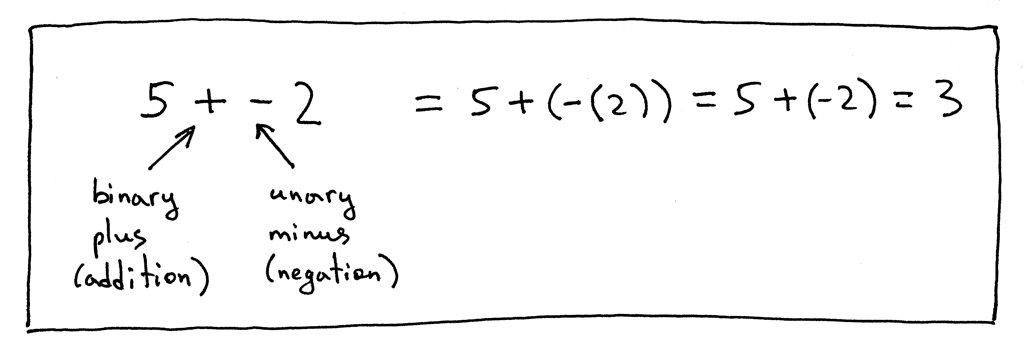
Figure 3: exp3
5 + - 2 = 5 + (- (2)) = 5 + (- 2) = 3
| \
\ unary minus(negation)
binary plus(addition)

Figure 4: exp4
5 - - - 2 = 5 - (- (- (2))) = 5 - (- (2)) = 5 - 2 = 3
| \ \
\ \ unary minus(negation)
\ unary minus(negation)
binary plus(addition)
现在让我们更新我们的语法来包含一元加减操作符。我们将会修改 factor 规则来增加一
元操作符,因为一元操作符相比于二元+,-,*,/操作符有更高的优先级。
这是修改前的 factor 规则:

Figure 5: factor before
factor : INTEGER | LPAREN expr RPAREN
而这是我们修改过的 factor 规则,可以处理一元加减操作符:

Figure 6: factor after
factor : (PLUS | MINUS) factor | INTEGER | LPAREN expr RPAREN
如你所见,我扩展了 factor 规则使它引用了自己,这使得我们可以派生出类似
“- - - + - 3” 的表达式,一个包含很多一元操作符的合法表达式。
下面是可以派生出包含一元加减操作符表达式的完整语法:

Figure 7: grammar
expr : term ((PLUS | MINUS) term)* term : factor ((MUL | DIV) factor)* factor : (PLUS | MINUS) factor | INTEGER | LPAREN expr RPAREN
下一步是添加一个表示一元操作符的 AST 结点类。
这个就可以:
1 | class UnaryOp(AST): |
构造函数有两个参数: op, 表示一元操作符的 token (加或减), expr, 表示一个
AST 结点。
我们更新后的语法修改了 factor 规则,所以我们需要在 parser 中修改 factor 方法。
我们会在方法中添加处理 “(PLUS | MINUS)” 子规则的代码:
1 | def factor(self): |
现在我们需要扩展 Interpreter 类,添加一个 visit_UnaryOp 方法来解释一元结点:
1 | def visit_UnaryOp(self, node): |
断续!
让我们手工建造一个表达式 “5 - - - 2” 的 AST 并把它传递给我们的 interpreter 来验
证新方法 visit_UnaryOp 可以工作。你可以在 Python shell 中这样做:
1 | >>> from spi import BinOp, UnaryOp, Num, MINUS, INTEGER, Token |
上面的语法树看上去是这样的:
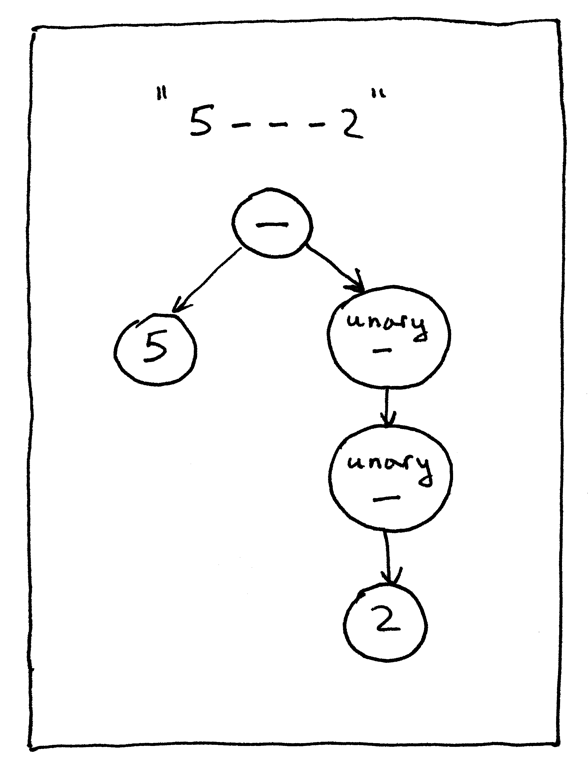
Figure 8: ast
直接从 GitHub 下载本文中 interpreter 的全部源代码。自己试一试,确认修改过的基于 语法树的 interpreter 可以正确地对包含一元操作符的算术表达式求值。
下面是某次运行过程:
$ python spi.py spi> - 3 -3 spi> + 3 3 spi> 5 - - - + - 3 8 spi> 5 - - - + - (3 + 4) - +2 10
我还更新了程序 genastdot.py 使得它可以处理一元操作符。下面是一些生成包含一元操作 符表达式生成树图像的例子:
1 | $ python genastdot.py "- 3" > ast.dot && dot -Tpng -o ast.png ast.dot |
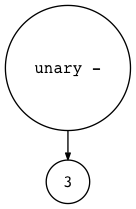
Figure 9: genastdot01
1 | $ python genastdot.py "+ 3" > ast.dot && dot -Tpng -o ast.png ast.dot |
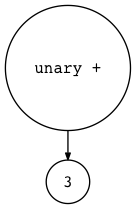
Figure 10: genastdot02
1 | $ python genastdot.py "5 - - - + - 3" > ast.dot && dot -Tpng -o ast.png ast.dot |

Figure 11: genastdot03
1 | $ python genastdot.py "5 - - - + - (3 + 4) - +2" \ > ast.dot && dot -Tpng -o ast.png ast.dot |

Figure 12: genastdot04
下面是给你的新练习:

Figure 13: exercise
安装 Free Pascal,编译并运行 testunary.pas,验证结果和你的 spi 解释器产生的一样。
这就是今天的所有内容。下一篇文章中,我们会处理赋值语句的问题。敬请关注,下次再见。
下面是我推荐的帮助你学习解释器和编译器的一些书:
- Language Implementation Patterns: Create Your Own Domain-Specific and General Programming Languages (Pragmatic Programmers)
- Writing Compilers and Interpreters: A Software Engineering Approach
- Modern Compiler Implementation in Java
- Modern Compiler Design
- Compilers: Principles, Techniques, and Tools (2nd Edition)
顺便说一下,我还在写一本书“et’s Build A Web Server: First Steps”,解释了怎么从头 写一个基本的 Web 服务器。你可以从这里, 这里 和 这里 来感受一下这本书。
本系列的所有文章:
- Let’s Build A Simple Interpreter. Part 1.
- Let’s Build A Simple Interpreter. Part 2.
- Let’s Build A Simple Interpreter. Part 3.
- Let’s Build A Simple Interpreter. Part 4.
- Let’s Build A Simple Interpreter. Part 5.
- Let’s Build A Simple Interpreter. Part 6.
- Let’s Build A Simple Interpreter. Part 7.
- Let’s Build A Simple Interpreter. Part 8.
- Let’s Build A Simple Interpreter. Part 9.
- Let’s Build A Simple Interpreter. Part 10.
- Let’s Build A Simple Interpreter. Part 11.
- Let’s Build A Simple Interpreter. Part 12.
- Let’s Build A Simple Interpreter. Part 13.
- Let’s Build A Simple Interpreter. Part 14.